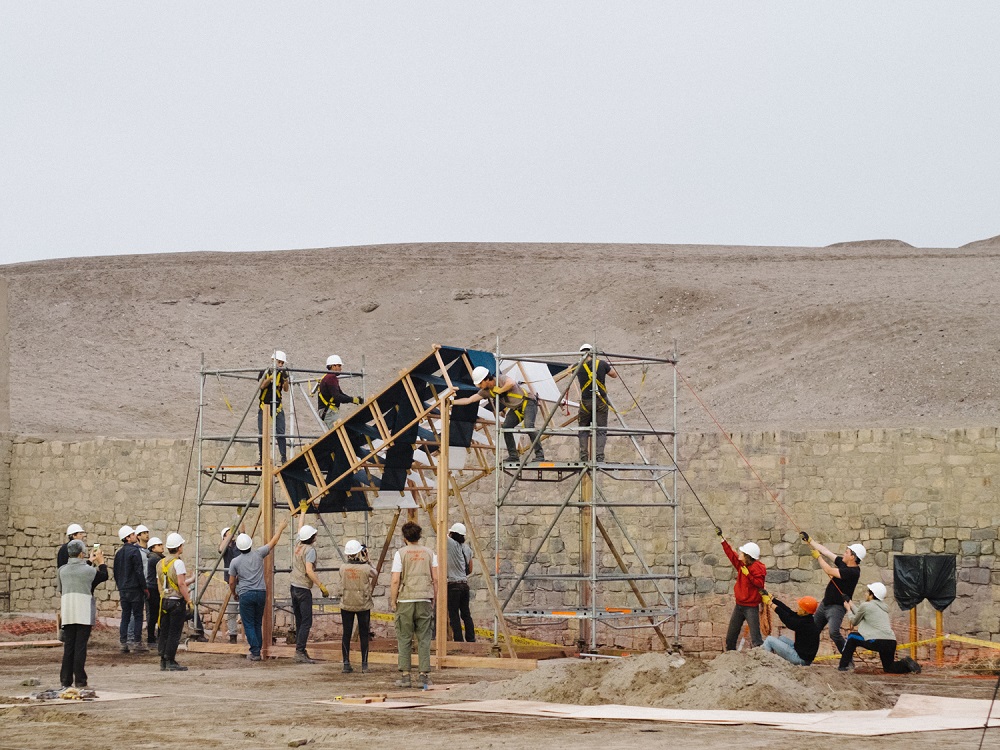In June 2018, some 45 students from ETH Zurich and the Pontifical Catholic University of Peru (PUCP) Lima worked together to design and build a “Room for Archaeologists and Kids” in the heart of the of the pre-Columbian sanctuary of Pachacámac, Peru. 10 months on, the site is now up and running, fully operational. In this new structure, archaeologists make their first examination of artefacts emerging from the nearby digs, shaded from the punishing Andean sun. The room is in full view of passing visitors and schoolchildren, who in turn, perform their own exploration in the sandpits across the courtyard. At each end, new finds are stored in rooms enclosed by woven cane walls before their transfer to the museum, for permanent conservation.
The Design-and-Build Studio
by Guillaume Othenin-Girard, 04.04.2019

Inner view of the Room for Archaeologists and Kids, Pachacámac, Peru, 2018 (photo credit: Studio Tom Emerson/ETH Zurich)
A room for archaeologists and kids in Pachacámac, Peru

Bamboo cane walls production for the bamboo cane panels
(photo credit: Studio Tom Emerson/ETH Zurich)
(photo credit: Studio Tom Emerson/ETH Zurich)
Direct engagement with construction is at the centre of our work at Studio Tom Emerson: we study how the world is made and remade, and how architecture and culture emerges from the act of making. From a personal perspective, this new collaborative project is undoubtedly my most profound teaching experience. It changed something in me: it confirmed my belief in our “design-and-build” pedagogical methodology. At the core of this philosophy, individuals have a role to play: a task one feels responsible for, and for which one is willing to give everything in order to contribute their share of the collective effort. This process cements trust between members of the group, and places self-initiative at the heart of the experience.
The project’s essence lies in the intensity of human exchanges between students of different cultural and social horizons, archaeologists both foreign and local, and key actors from the surrounding communities. It is a relief and a rare privilege to witness the impact of our structure and the making of it on the people living and working in-situ. Any initial doubts concerning our intentions are gone. I am proud of belonging to such a group of people, sharing, even for an instant, a similar ideal: to create something both beautiful and meaningful. Based on this venture I have a renewed faith in what architecture can do, beyond the shackles of form, shape, and effect. Our ambition is to make architecture accessible to the world; an architecture that does not merely point out a reality, but creates a shared experience of it.

Design and build team for our Room for Archaeologists and Kids (photo credit: Studio Tom Emerson/ETH Zurich)
If you are hooked, please have a look at the short film made by Géraldine Recker, one of the 14 students of the Department of Architecture at ETH Zurich who took part in this adventure. She managed to capture the scale and the identity of this most extraordinary archaeological landscape, and wove it together with the construction process and Quechua ritual ceremony performed during the latter.

About the author
Guillaume Othenin-Girard works on architecture, publishing and curatorial projects. He holds a Master’s Degree in architecture from ETH Zurich where, since 2015, he taught the second year program for design and construction in the Chair of Prof. Tom Emerson, as well as leading the design-build research project Archaeology of the Territory; A Room for Archaeologists and Kids with PUCP Lima in Peru. He was a studio director in the first year program of the School of Architecture at EPF Lausanne and a member of ALICE design research team and EPFL+ECAL Lab. He is the author of Go Field and Towers (Amarillo Press, 2017), an approach to teaching and architecture centred around the body’s experience of space and articulated through a direct manual relationship with drawing and building. He co-founded the independent teaching unit Re:public Books and Buildings with Prof. Maarten Delbeke, a pedagogical programme that calls for a renewal of the way architects regard and transform the city. His work has been exhibited at the Venice Architecture Biennale (2012), Artgeneva (2016, 2017) and Art Basel (2018). Guillaume is a founding member of TEN, a design research studio based in Zurich, winner of the Swiss Art Award for Architecture in 2018.








